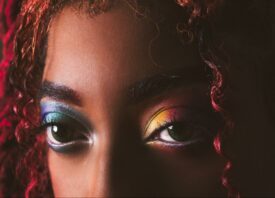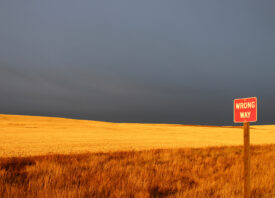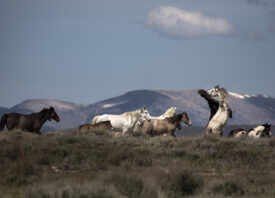Search this site
An NFT Collection Gives Voice to America’s Wild Horses
“It’s the subtle details of the mustangs that I love most,” the photographer Jessica Cardelucci says. “The wind knots in their manes almost tell their tale. Tangled, yet wild and beautiful.” From 2016 through 2019, she traveled through public lands throughout the American West, searching for mustangs. Her quest to photograph our country’s wild horses* coincided with the passing of her beloved horse, with the artist returning to the wild time and again as reconnecting with them–a kind of homecoming.
Now, her journey has culminated in Wild Mustangs, a collection of twenty images available as 1/1 NFT editions and handmade platinum prints. Just a single platinum print and proof are created for each photograph. The choice to release the photographs as unique NFTs and one-of-kind prints was deliberate, mirroring the rare and fleeting moments she shared with these animals and also the precariousness of their future.
71,735 wild horses and 14,454 burros live free on the range. In the United States, the Bureau of Land Management conducts roundups of wild horses and burros, removing them from their homes in the wild. These roundups are frequently carried out by helicopters, driving the horses across great distances before separating them in pens.
Some are released back into the wild, but most are put up for adoption. Tens of thousands of those who are not adopted end up in government-holding facilities. Those who slip through the cracks might be sold or adopted to kill buyers and slaughtered; their numbers remain unknown.
Today, Return to Freedom, a nonprofit organization working on behalf of our country’s horses, provides sanctuary to more than 450 wild horses and burros. Cardelucci has been able to give back to them through the sales of her artwork.
“I feel my part in all of this is to get out there to witness and document the wild mustangs for myself and continue to share their story,” she tells me. “I aim to help the public be more aware of what’s going on and value these horses as I do.” These horses live on public lands, so accessing them is, in theory, a simple matter. Finding them, however, can be more difficult. “Not all of them are as heavily documented or easily accessible as others,” the artist admits. “I’ve only been able to photograph a few herds out of the many I’d love to see over my lifetime.”
Any trip starts with thorough research into the 177 herd management areas across 10 western states, managed by the Bureau of Land Management. Often, Cardelucci’s work involved traveling into remote areas, and there’s always a risk of getting stuck. Safety is the priority, and she never goes alone. She’s been around horses for much of her life, but in some ways at least, the mustangs were different. For her own safety and ethical reasons, she remained hundreds of feet from the horses, never interfering with or altering their behavior.
Even then, working in the field can be unpredictable. “Once, we were about 500-plus feet away from a herd, and I was using a large telephoto lens, observing the horses when something spooked them,” the artist remembers. “Normally, horses run away from people if startled, but because whatever startled them was in the other direction, they started stampeding towards us.
“We were not close enough to our car so I started to throw up my tripod to ‘act big’ and make sure they didn’t come near us–a stampeding herd of horses is actually extremely dangerous. Thankfully, they went around us, and I was able to get some incredible up-close images of the horses running wild, but I also hope that never happens again in this way. Even though I put safety first, there are still situations in the wild you can’t control, and this is one I won’t forget. I got some great images of the horse running I had been dreaming of, but it’s not exactly how I pictured it happening.”
While that instant was over in a flash, Cardelucci hopes the horses will remain–wild and free–for generations to come. Her photographs have also been made to weather the passage of time. “Platinum prints can last hundreds if not thousands of years, essentially as long as the paper,” she says. “I wanted these images to be treasured and last a lifetime to preserve the uncertainty I see in many of these horses’ future.”
In early 2021, as NFTs took the art world by storm, she started to consider blockchain technology in the context of her own work. “After months of thinking about it, I finally decided I wanted to offer my images additionally in this new format,” she remembers. “I felt offering a 1/1 NFT was a way to still preserve the history of these magnificent horses in a unique way that compliments my physical prints, but has also allowed me to share their story in a broader way.
“If I was still only selling prints I don’t think we’d be having these conversations about the horses right now, and that is what is truly amazing. The NFT space has opened up the industry for artists to directly connect with so many collectors and art lovers on a level I’m not sure has ever been experienced before. It’s truly global.”
For all the movement and joy contained within the collections, Wild Mustangs is just as much about the quiet moments as it is the thrilling ones. Perhaps this idea is best expressed in Mustang and Bird, a photograph of a stallion grazing, a bird perched atop his back. In September of last year, Mustang and Bird was acquired by Justin Aversano, a fellow photographer who’s shattered records and made history on the blockchain.
“I have a soft spot for the stallion in my image Mustang and Bird,” Cardelucci tells me. “It’s very subtle from his thicker coat, but you can subtly see the Zebra-looking stripes on his upper legs. He also has what’s called a dorsal stripe down his back. These are less common traits in the mustangs that come from Spanish lineage in the horses. Each herd has its own genetic characteristic, so it’s a treasure to see wild horses with these markings.”
* In the United States, these horses are protected under the Wild Free-Roaming Horses and Burros Act of 1971.
All images © Jessica Cardelucci















